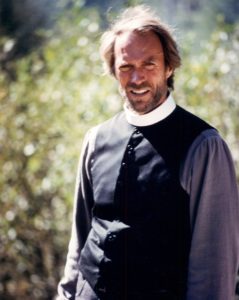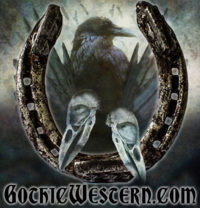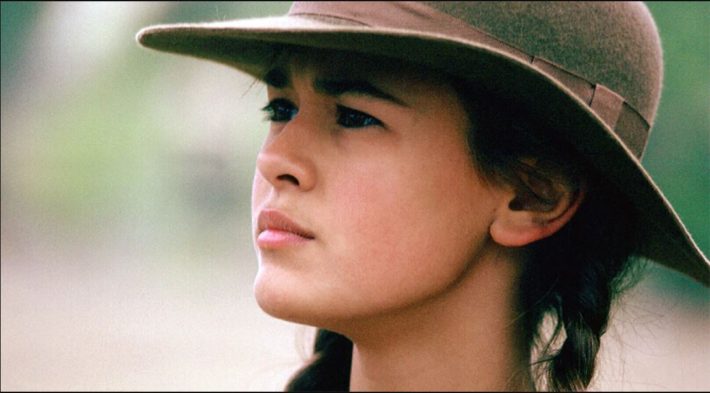The following is part three of a four part series by John Edgar Browning about Clint Eastwood’s Pale Rider (1985), taken from “Undead in the West II: They Just Keep Coming“, a book chronicling films in the Gothic Western and Weird Western genre.
Outwardly, Eastwood’s character is part Mexican campesino (peasant), part American cowboy, and the effect is one of grotesquery. The fusion of these two character types, who in traditional Westerns “had always stood diametrically opposed to each other,” according to Leeuwen, is here central: the heroic cowboy (immortalized by John Wayne) and the Mexican or Indian outlaw .. . . The grotesque effect of this mode of characterization on the viewer is that he or she is forced to conclude that not all people wearing a poncho and a sombrero are slothful and dim-witted.” Notable as well in these films is the theme of the “pursuit of capital,” which fundamentally shifts from being characteristically negative (as in the classic American Westerns) to considerably more “neutral” or “circumstantial” (as in the spaghetti Westerns), capable in its design of granting or denying legitimacy. In this way, many spaghetti Westerns and Gothic Eurowesterns can be called “capital Westerns” or “capital narratives.” These qualities— both the capital narrative and the “grotesque” characterization outlined by Frayling— would eventually figure into Eastwood’s “American” take on the Gothic Western as well, in High Plains Drifter and Pale Rider. Eastwood’s Death Rider Epics High Plains Drifter is a film about a stranger on horseback who materializes from the desert to take revenge on his killers and the money-grubbing community that stood by and watched him die, and it is Pale Rider’s only Gothic-visaged precursor in America. In it, Eastwood solidly “reverses the naive [American] western pattern of the relation of hero and community,” according to Beard. “The transcendental cowboy hero,” played by Eastwood, “arrives mysteriously from outside the community; but instead of saving it from the villains,” Beard notes, “he delivers it over to them and watches its destruction with extreme satisfaction before turning on the villains him self.” T he community, however, “is (mostly) just as bad as the villains.” T he community’s haunted past firmly situates it in the Gothic tradition, and the revenge of Marshal Jim Duncan upon the townspeople who betrayed him is no less typical of the Gothic aesthetic. A s the (anti) hero, Beard explains (extending Will W right’s structural analysis of the genre), he “begins in a position o f alienation from, and even hatred for, society and only gradually works his way back to a pro-social function.” Yet, not only does Eastwood’s character in High Plains Drifter fail to relinquish his contempt for the town that betrayed him, but he also becomes its judge and executioner. The stranger’s supernatural abilities even suggest that he may be divine in origin, an idea, notes Beard, made “stronger still in Pale Rider.’’
 Abandoning the arid terrain of High Plains Drifter, Pale Rider takes place in Carbon Canyon: a forested, mountainous region and the site of a goldbearing stream worked by Hull Barret and his small community of prospectors and coveted by mining baron Coy LaHood for his hydraulic mining operations. The film opens with LaHood’s henchmen staging a raid on the unsuspecting miners, destroying their property, and killing or maiming their livestock and pets. It is the latest in a series of similar raids, designed to drive them off their land, and with each attack, their financial security grows more tenuous. O n the afternoon following the raid, with hope for the community all but gone, young Megan W heeler (Sydney Penny) ventures out into the adjacent forest to bury her dog, which was intentionally shot and killed by the raiders. Over her fallen animal’s fresh grave, Megan prays for a miracle, and at that moment, a mysterious stranger riding a pale horse begins to descend from the local snow-peaked mountains. Meanwhile, undeterred by LaHood’s violence, Barret rides into the nearby town to buy replacements for some o f the goods destroyed during the raid. While in town, he is jumped by some of the same ruffians who raided the settlement, but he is rescued by the stranger on the pale horse, who appears out of nowhere and single-handedly defeats his attackers using only an axe handle as a weapon. Barret thanks the stranger and invites him to stay at the home that he shares with his fiancée— Megan’s mother— at the nearby mining colony. T he nameless stranger comes to be known as “Preacher” (after revealing him self as one), and in time, he lifts the spirits of the colonists by his willingness to stand up to LaHood and his henchmen. He refuses a substantial bribe from LaHood, inspiring the colonists to follow suit by turning down the mining baron’s suspiciously generous offer to buy out their claims A s a last resort, LaHood summons a marshal named Stockburn and his deputies, who “serve whatever law pays them the most.” Preacher departs for a town a day’s ride away, retrieving a holster and gun from a safe deposit box and leaving in its place his white priest’s collar. U pon his return to the colony, he makes a gruesome discovery: a colonist who had just unearthed a large gold deposit has been shot and killed in town by Stockburn and his deputies. Early the next morning, Preacher— with Hull’s assistance— sabotages LaHood’s local mining encampment, then proceeds alone into town In a shootout, he kills Stockburn’s deputies and, finally, Stockburn himself before riding back into the mountains from which he came. T he Gothic setting and mood in which Pale Rider wraps these even Is are established in its opening credits. Shots of the mining colony’s peaceful demeanor are juxtaposed with a wide-angle shot revealing towering snow peaked mountains that ascend into the heavens and a vast pine forest at their feet: familiar elements in the Gothic sublime aesthetic. The film shifts back and forth between shots of the quietly working miners and their families and shots of a twenty-man raiding party emerging from the forest and thunderously speeding toward the colony. This continuous cross-cutting between audibly opposed settings is grotesque and builds discomfort in the viewer, until finally the thunderous horses of the raiding party can be distantly heard over the horizon by the colonists, who begin to realize that an attack is imminent. After the devastating raid by the marauding ruffians, Megan carries her small dog into the neighboring forest to bury him. The “look” of the forest is designed with an almost chiaroscuro effect, a motif typical of the Gothic as well as Mannerist paintings, which were especially influential on the Gothic. The play of shadow, light, and a faint haze underscore her trek through the pines. Megan stoops by the tiny grave and begins to pray, lamenting that she and the colony should have to endure such horrors. As she recites “I shall fear no evil,” the camera cuts from her kneeling position to the sky overhead, which takes on a foreboding aspect, as if a brooding storm is reacting to her words. The camera then
Abandoning the arid terrain of High Plains Drifter, Pale Rider takes place in Carbon Canyon: a forested, mountainous region and the site of a goldbearing stream worked by Hull Barret and his small community of prospectors and coveted by mining baron Coy LaHood for his hydraulic mining operations. The film opens with LaHood’s henchmen staging a raid on the unsuspecting miners, destroying their property, and killing or maiming their livestock and pets. It is the latest in a series of similar raids, designed to drive them off their land, and with each attack, their financial security grows more tenuous. O n the afternoon following the raid, with hope for the community all but gone, young Megan W heeler (Sydney Penny) ventures out into the adjacent forest to bury her dog, which was intentionally shot and killed by the raiders. Over her fallen animal’s fresh grave, Megan prays for a miracle, and at that moment, a mysterious stranger riding a pale horse begins to descend from the local snow-peaked mountains. Meanwhile, undeterred by LaHood’s violence, Barret rides into the nearby town to buy replacements for some o f the goods destroyed during the raid. While in town, he is jumped by some of the same ruffians who raided the settlement, but he is rescued by the stranger on the pale horse, who appears out of nowhere and single-handedly defeats his attackers using only an axe handle as a weapon. Barret thanks the stranger and invites him to stay at the home that he shares with his fiancée— Megan’s mother— at the nearby mining colony. T he nameless stranger comes to be known as “Preacher” (after revealing him self as one), and in time, he lifts the spirits of the colonists by his willingness to stand up to LaHood and his henchmen. He refuses a substantial bribe from LaHood, inspiring the colonists to follow suit by turning down the mining baron’s suspiciously generous offer to buy out their claims A s a last resort, LaHood summons a marshal named Stockburn and his deputies, who “serve whatever law pays them the most.” Preacher departs for a town a day’s ride away, retrieving a holster and gun from a safe deposit box and leaving in its place his white priest’s collar. U pon his return to the colony, he makes a gruesome discovery: a colonist who had just unearthed a large gold deposit has been shot and killed in town by Stockburn and his deputies. Early the next morning, Preacher— with Hull’s assistance— sabotages LaHood’s local mining encampment, then proceeds alone into town In a shootout, he kills Stockburn’s deputies and, finally, Stockburn himself before riding back into the mountains from which he came. T he Gothic setting and mood in which Pale Rider wraps these even Is are established in its opening credits. Shots of the mining colony’s peaceful demeanor are juxtaposed with a wide-angle shot revealing towering snow peaked mountains that ascend into the heavens and a vast pine forest at their feet: familiar elements in the Gothic sublime aesthetic. The film shifts back and forth between shots of the quietly working miners and their families and shots of a twenty-man raiding party emerging from the forest and thunderously speeding toward the colony. This continuous cross-cutting between audibly opposed settings is grotesque and builds discomfort in the viewer, until finally the thunderous horses of the raiding party can be distantly heard over the horizon by the colonists, who begin to realize that an attack is imminent. After the devastating raid by the marauding ruffians, Megan carries her small dog into the neighboring forest to bury him. The “look” of the forest is designed with an almost chiaroscuro effect, a motif typical of the Gothic as well as Mannerist paintings, which were especially influential on the Gothic. The play of shadow, light, and a faint haze underscore her trek through the pines. Megan stoops by the tiny grave and begins to pray, lamenting that she and the colony should have to endure such horrors. As she recites “I shall fear no evil,” the camera cuts from her kneeling position to the sky overhead, which takes on a foreboding aspect, as if a brooding storm is reacting to her words. The camera then  pans down to the sublime facade of the cragged, snow-capped mountains that overlook the valley. Megan, still on her knees, prays for a miracle (“in an homage to Shane,” writes Carl Plantinga, during which the music cue suggests youth and innocence. The shot then partially dissolves to a dark-clad stranger atop a pale horse descending the mountains, juxtaposing his image and Megan’s. He almost seems to arrive with winter. The music suddenly transitions from Megan’s soft peaceful melody to a more ominous tone as the stranger comes more and more into focus. The dissolve and juxtaposition of Megan and the stranger repeat several times, as do the musical cues. This back-and-forth cutting is more in line with the visual and auditory grammars of horror than with those of a typical Western. Preacher, the film’s central Gothic figure, also appears out of nowhere— albeit more dramatically and abruptly— during the assault on Hull by LaHood’s henchmen. Then, in a show of chivalry that harkens back to early European Gothic works, he defends the weakened Barret by taking on all six of his assailants with the aid of only an axe handle. Similarly, in a scene in which LaHood’s son Josh attempts to rape Megan, the Preacher miraculously shows up and delivers her from harm’s way “in a courtly tradition” that recalls the European Gothic. The peculiar manner in which he wields the axe handle— reminiscent of a medieval broadsword— also serves to situate him in a bygone time, and his clothes reinforce the strikingly outdated appearance that he presents. The Preacher’s black shirt, characteristic black Stetson hat (in a style worn by no one else in the film), and boots are accentuated by a long, dull brown coat weathered in a way that gives it a reddish hue. (This black/red palette has figured prominent in Gothic narratives and horror cinema and also in High Plains Drifter, where the Stranger orders the town of Lago painted red.) After Preacher subdues the ruffians, Hull can hardly react before his rescuer exits, in ghostlike fashion, as quickly as he appeared. Leeuwen argues that the black hat and boots of Django’s protagonist “reveal his symbolic function in the film as an agent of destruction. Unlike the Hollywood westerns in which the color black symbolized the villain, the informed Gothic Eurowestern viewer will identify this destructive figure as a hero.” Preacher’s subsequent arrival at Hull’s cottage in the colony underscores this point. Megan— who has yet to meet Preacher— is inside reading from the Bible, Revelations (6:7-8), from which the film’s title is derived: “And when he had opened the fourth seal, I heard the voice of the fourth beast say, Com e and see. And I looked, and behold a pale horse: and his name that sat on him was Death, and Hell followed with him.” Most striking, we as viewers hear her voice reading the scripture off camera as Preacher dismounts from his pale horse. Preacher’s character is defined by a “collection of external gestures, mannerisms, stylish articles of clothing, or even motifs on the soundtrack” like those that, according to Frayling, distinguish the (anti)hero in the Gothic Eurowestern.
pans down to the sublime facade of the cragged, snow-capped mountains that overlook the valley. Megan, still on her knees, prays for a miracle (“in an homage to Shane,” writes Carl Plantinga, during which the music cue suggests youth and innocence. The shot then partially dissolves to a dark-clad stranger atop a pale horse descending the mountains, juxtaposing his image and Megan’s. He almost seems to arrive with winter. The music suddenly transitions from Megan’s soft peaceful melody to a more ominous tone as the stranger comes more and more into focus. The dissolve and juxtaposition of Megan and the stranger repeat several times, as do the musical cues. This back-and-forth cutting is more in line with the visual and auditory grammars of horror than with those of a typical Western. Preacher, the film’s central Gothic figure, also appears out of nowhere— albeit more dramatically and abruptly— during the assault on Hull by LaHood’s henchmen. Then, in a show of chivalry that harkens back to early European Gothic works, he defends the weakened Barret by taking on all six of his assailants with the aid of only an axe handle. Similarly, in a scene in which LaHood’s son Josh attempts to rape Megan, the Preacher miraculously shows up and delivers her from harm’s way “in a courtly tradition” that recalls the European Gothic. The peculiar manner in which he wields the axe handle— reminiscent of a medieval broadsword— also serves to situate him in a bygone time, and his clothes reinforce the strikingly outdated appearance that he presents. The Preacher’s black shirt, characteristic black Stetson hat (in a style worn by no one else in the film), and boots are accentuated by a long, dull brown coat weathered in a way that gives it a reddish hue. (This black/red palette has figured prominent in Gothic narratives and horror cinema and also in High Plains Drifter, where the Stranger orders the town of Lago painted red.) After Preacher subdues the ruffians, Hull can hardly react before his rescuer exits, in ghostlike fashion, as quickly as he appeared. Leeuwen argues that the black hat and boots of Django’s protagonist “reveal his symbolic function in the film as an agent of destruction. Unlike the Hollywood westerns in which the color black symbolized the villain, the informed Gothic Eurowestern viewer will identify this destructive figure as a hero.” Preacher’s subsequent arrival at Hull’s cottage in the colony underscores this point. Megan— who has yet to meet Preacher— is inside reading from the Bible, Revelations (6:7-8), from which the film’s title is derived: “And when he had opened the fourth seal, I heard the voice of the fourth beast say, Com e and see. And I looked, and behold a pale horse: and his name that sat on him was Death, and Hell followed with him.” Most striking, we as viewers hear her voice reading the scripture off camera as Preacher dismounts from his pale horse. Preacher’s character is defined by a “collection of external gestures, mannerisms, stylish articles of clothing, or even motifs on the soundtrack” like those that, according to Frayling, distinguish the (anti)hero in the Gothic Eurowestern.
John Edgar Browning



